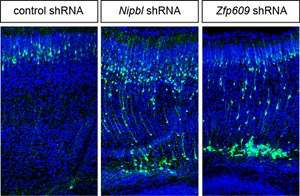Discovery of gene effects on brain brings scientists closer to understanding rare developmental disorder

Scientists are closer to finding additional genetic causes for the rare developmental disorder Cornelia de Lange Syndrome after discovering the steps in brain development that may be affected in some patients.
The findings come from a team at the Francis Crick Institute who worked with colleagues at the Proteomics Centre at Erasmus University Medical Centre in The Netherlands.
Debbie van den Berg, who is in François Guillemot's group at the Crick, explains: "Cornelia de Lange Syndrome affects the central nervous system. Patients experience seizures and various degrees of intellectual disability.
"For seven in every 10 patients the altered genes that cause the syndrome are known, but it is not understood how these alterations influence brain development. For the other three in 10 patients, the genetic cause is unknown."
Researchers have previously found that over half of patients with Cornelia de Lange Syndrome have mutations in one of two copies of a gene called cohesin loading factor Nipped-B-like (NIPBL). These patients tend to be more severely affected than those without a mutation in this gene. However, how NIPBL acts in gene regulatory networks and developmental pathways in brain development was poorly understood.
The researchers discovered in mice that the Nipbl protein binds to two other protein factors, called Zfp609 and the Integrator complex. They found that, together, these three factors regulate how nerve cells travel from their site of origin to their final destination in the developing brain.
When the scientists disabled Nipbl, Zfp609 or Integrator in mouse brains, their nerve cells failed to reach the correct positions. This affected the building and wiring of their brains, which can result in the neurological problems seen in patients with Cornelia de Lange Syndrome.
Dr van den Berg says: "We now have a better understanding of which steps in brain development are affected in this disease. Our data have provided new clinical insights and have contributed candidate genes for mutation screening in this and other intellectual disability syndromes."
Dr Guillemot adds: "By screening for mutations in the genes for these additional regulator proteins - Zfp609 and the Integrator complex - we might be able to find a genetic cause for Cornelia de Lange Syndrome in patients for whom no cause has been found so far."
More information: Debbie L.C. van den Berg et al. Nipbl Interacts with Zfp609 and the Integrator Complex to Regulate Cortical Neuron Migration, Neuron (2016). DOI: 10.1016/j.neuron.2016.11.047















